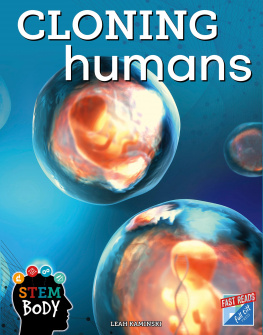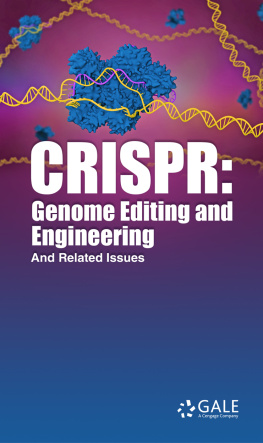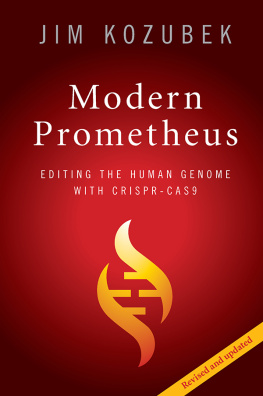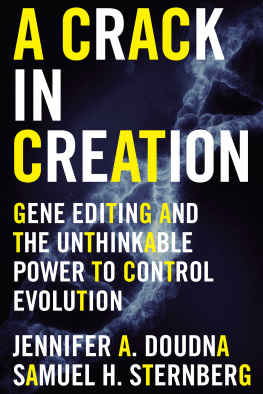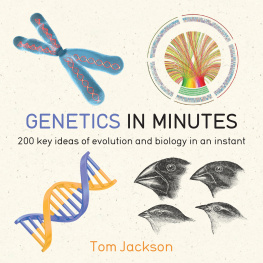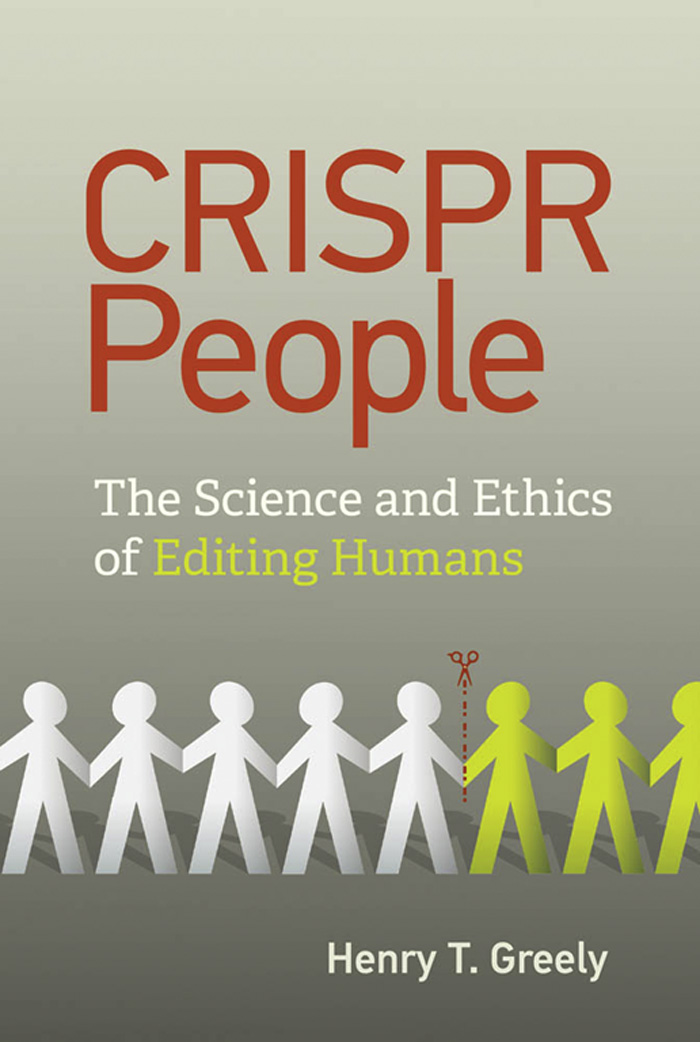
CRISPR People
CRISPR People
The Science and Ethics of Editing Humans
Henry T. Greely
The MIT Press
Cambridge, Massachusetts
London, England
2021 Massachusetts Institute of Technology
All rights reserved. No part of this book may be reproduced in any form by any electronic or mechanical means (including photocopying, recording, or information storage and retrieval) without permission in writing from the publisher.
This book was set in ITC Stone Serif Std and PF DIN by New Best-set Typesetters Ltd.
Library of Congress Cataloging-in-Publication Data
Names: Greely, Henry T., author.
Title: CRISPR people : the science and ethics of editing humans / Henry T. Greely.
Description: Cambridge, Massachusetts : The MIT Press, [2021] | Includes bibliographical references and index.
Identifiers: LCCN 2020012654 | ISBN 9780262044431 (hardcover)
Subjects: MESH: Gene Editing | Genome, Human
Classification: LCC QH447 | NLM QU 550.5.G47 | DDC 611/.0181663dc23
LC record available at https://lccn.loc.gov/2020012654
10 9 8 7 6 5 4 3 2 1
d_r0
To John and Eleanor, non-CRISPRd children who taught me about being a parent
Contents
Introduction
On Sunday night, November 25, 2018, I finished dinner at my home in California and sat down to my computer. As I pulled up my email, a message sent at 7:37 that evening from a friend caught my eye, mainly because of its subject lineCRISPR babies. The email contained a link to a news story by Antonio Regalado, a reporter with MIT Technology Review. The title of the story more than caught my eye: Exclusive: Chinese Scientists Are Creating CRISPR Babies. was planning to use the DNA editing tool CRISPR (which stands for clustered regularly interspaced short palindromic repeats) to change the DNA of human embryos that would be transferred into womens uteruses for possible pregnancy and birthCRISPR babies.
A quick look at my (exploding) Twitter feed almost immediately led me to an Associated Press (AP) story by Marilynn Marchione. That story was based on at least seven weeks of discussions with He and his colleagues.
Dr. He claimed to have overseen the use of CRISPR to modify a gene in the human embryos that is called CCR5, a gene known to be important in allowing HIV to infect some human cells. His goal was to make the gene inoperative and thus deprive HIV of that gateway for infection. Two edited embryos, of nonidentical twin sisters, were transferred into their mothers uterus sometime in late March or early April 2018. Sometime in October, somewhere in China, they were born.
Regalado had first posted his article at about 7:15 Eastern Time on Sunday night, but by then it was already after 8:00 on Monday morning in Hong Kong, where the Second International Human Genome Editing Summit (the Summit) was due to open the following morning. The Summit, which followed a first summit in December 2015, had been organized by the U.S. National Academy of Sciences, the U.S. National Academy of Medicine, the U.K. Royal Society, and the Hong Kong Academy of Sciences. The meeting was a big deal. He Jiankui had fairly recently been added to the list of speakers, though not to talk about CRISPRd babies. None of the organizers seem to have learned about his actions earlier than the following Thursday; almost all the rest of the world was taken totally by surprise. But his experiment would clearly dominate the Summit and its coverage.
That evening reminded me of another Sunday, more than 20 years before. On Sunday, February 23, 1997, at about 11:00 a.m., my then dean called me at home. I was not accustomed to getting phone calls at home from my dean and started searching my conscience. I did not have long to worryhe said to me, in excited tones, something like Theyve cloned a sheep! I thought you should know.
Dolly, the worlds first mammal cloned from adult cells, was born in early July 1996, but her birth was kept secret until the researchers, Ian Wilmut and colleagues from the Roslin Institute in Scotland, could publish their scientific paper on her. On the Friday before, Nature had sent out its usual press release about its upcoming issue, which included the scientific article on Dolly. and the news flashed immediately around the world.
I dont remember what I said to my dean, but I do remember thinking, Things are about to get interesting. On Sunday, November 25, 2018, I had the same reaction. Both times, I was right.
This book is my reaction to the He Jiankui experiment, an experiment that feels like a cross between bad fiction and reckless fiasco, shrouded in a deep fog of secrets. Part I of the book provides some background to the He Jiankui announcement. Its first chapter describes what He actually did, as much as we know, which is still surprisingly little. The second and third chapters explain human germline genome editing and CRISPR. The fourth and fifth chapters describe the ethical discussions about and legal status of human germline genome editing before November 25, 2018.
Part II details the revelation of He Jiankuis experiment in November 2018 in the sixth chapter. The seventh and eighth chapters talk about the fallout from those revelations.
Part III of the book deals with assessments. It weighs the He Jiankui experiment in chapter 9. (Spoiler alertI conclude it was grossly reckless, irresponsible, immoral, illegal, and probably fattening.) Chapter 10 lays out some immediate responses that the scientific community (Science) in general should have made, as well as some that China should have done, and describes what has been actually been done.
Part IV, the final part, asks more broadly about human germline genome editing: Now What? Chapters 11, 12, and 13 look at the technique broadly, not just in the context of the He experiment. Chapter 11 asks whether the technique is inherently bad (I conclude it is not). Chapter 12 looks at other problems human germline genome editing may cause. And chapter 13 examines the other side of the cost/benefit analysiswould human germline genome editing be very good for anything? Chapter 14 analyzes what kinds of safety testing we would want to apply if we decided seriously to explore going forward with human germline genome editing. And chapter 15 weighs the public policy options of a total ban or regulated use before ending by trying to answer how decisions about this technology should be made. And then, at the end, you get the conclusion.
This book is not entirely second- and thirdhand reporting by me. I was involved importantly in one of the events it discusses and secondarily in some others. Ive followed the discussions closely for over five years, and I know personally many of the characters in this play (whether tragedy or farce remains to be seen). All authors will bring their biases and personalities to their work, intentionally or not. In this case, I am trying to give what is, in many places, an openly personal account of the story. You have been warned!
Human germline genome editing invokes many troubling, tricky, and deep general questions. But I am an American lawyer by training. We like looking at cases and working our way from specific examples to broader laws, principles, guidelines, or even rules of thumb. All settings are different, but they provide the opportunity to see consequences and concerns evoked in the real world that might be missed in the solitude of a scholars study or even in the busy hum of an engaged classroom. The He Jiankui affair puts the many concerns about human germline genome editingand many other forms of assisted reproduction as well as other human interventions we humans make in ourselvesinto a concrete setting. And it tells a fascinating, unnerving, and still unclear story. I hope you enjoy reading about it as much as I enjoyed writing about it.
Next page

